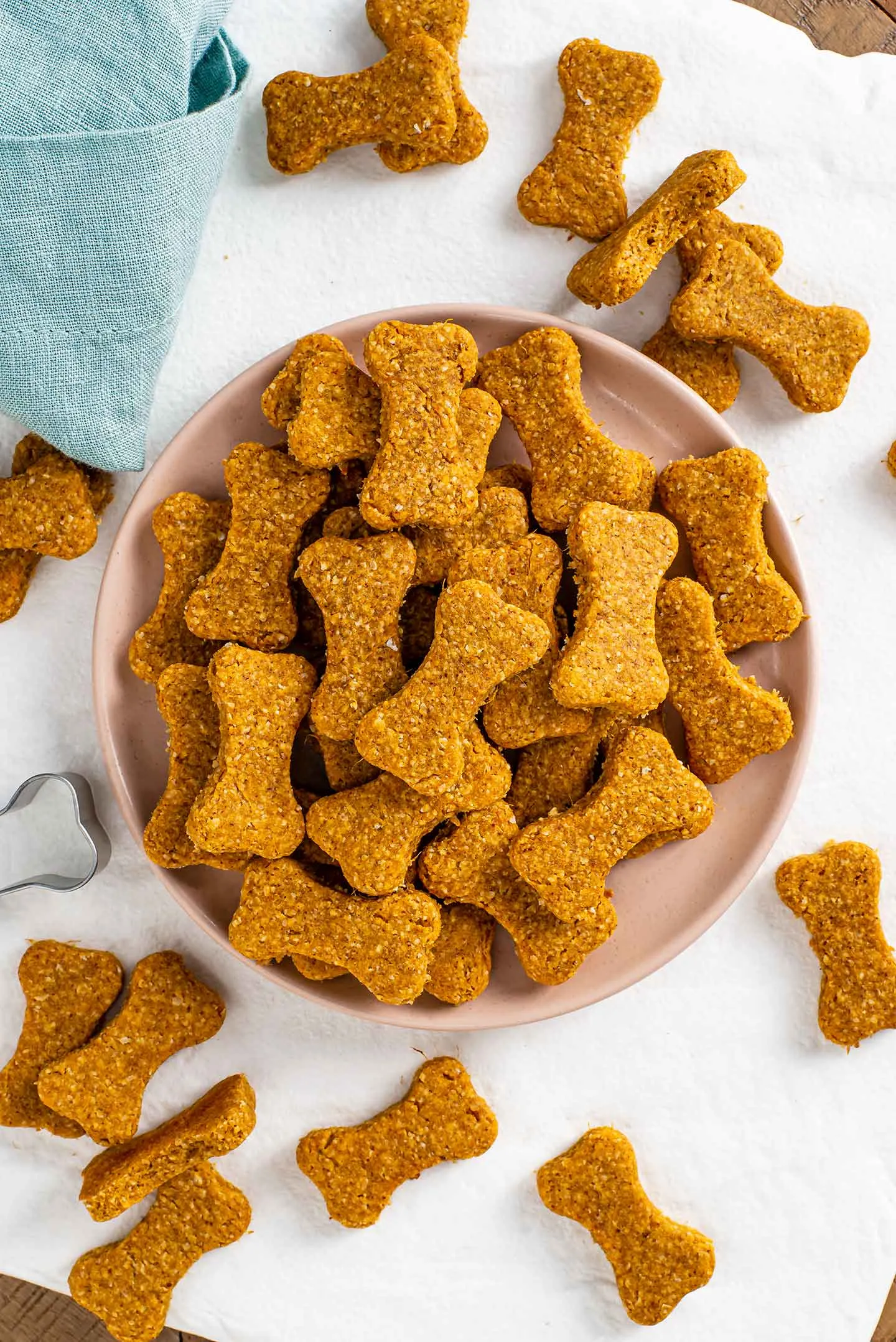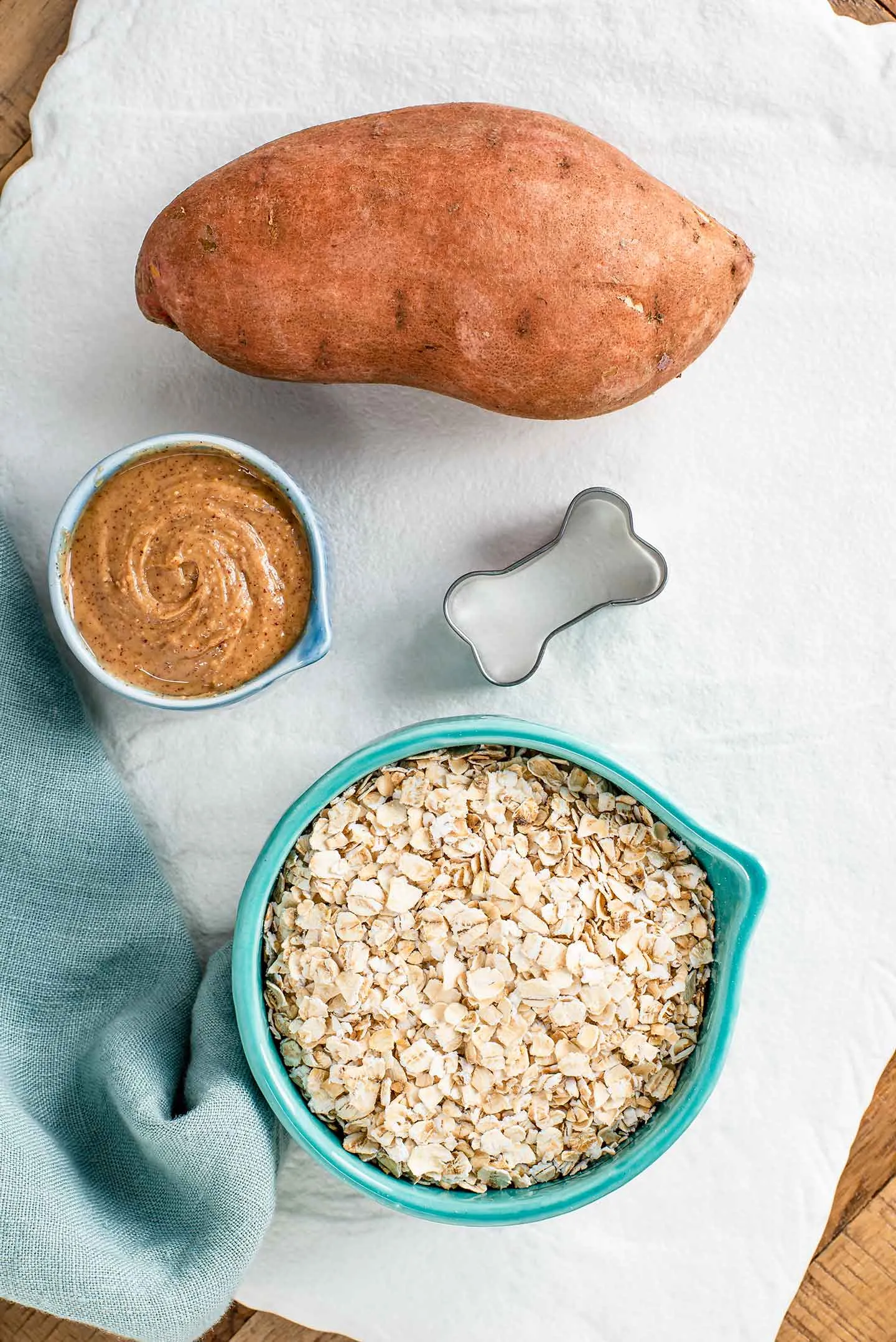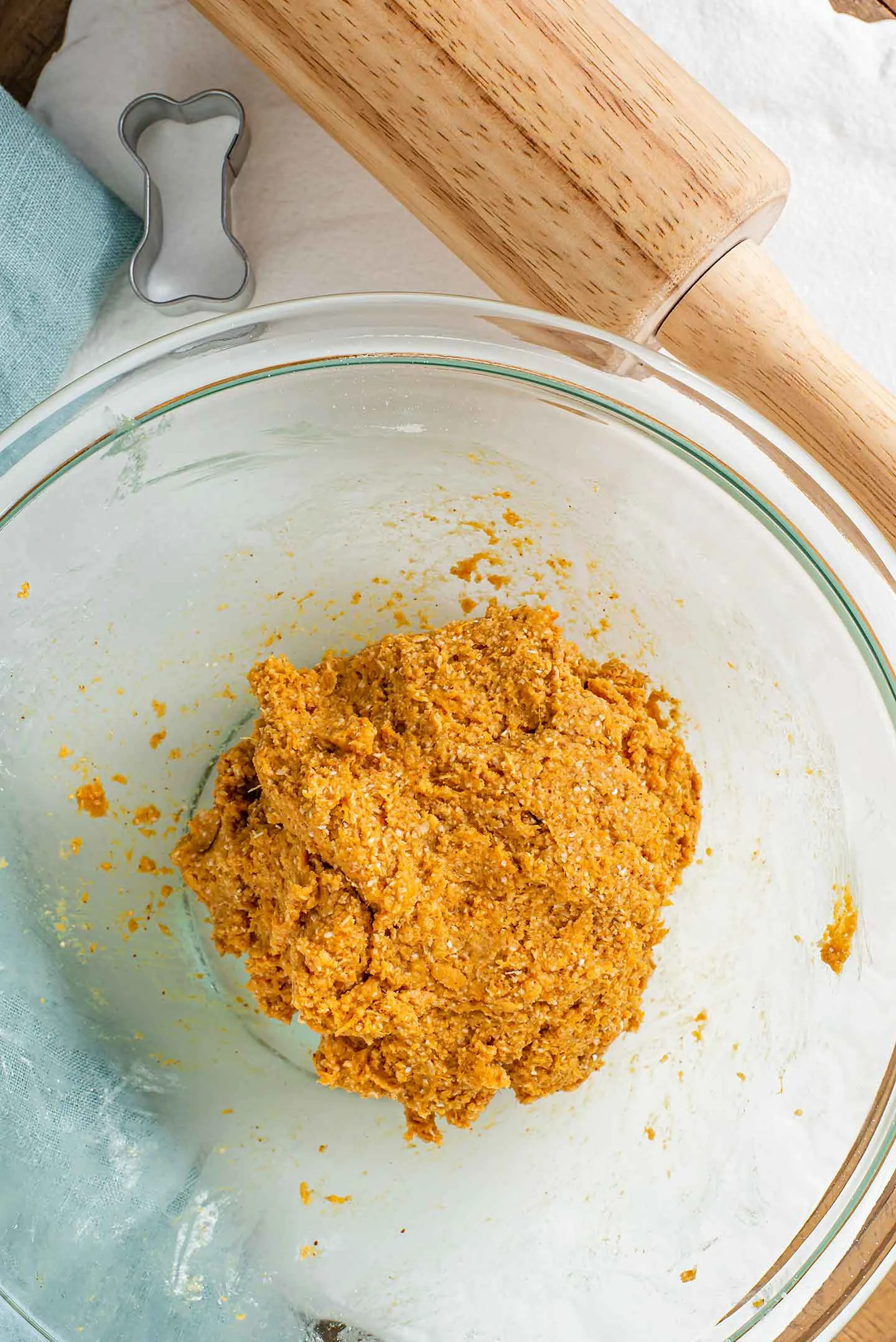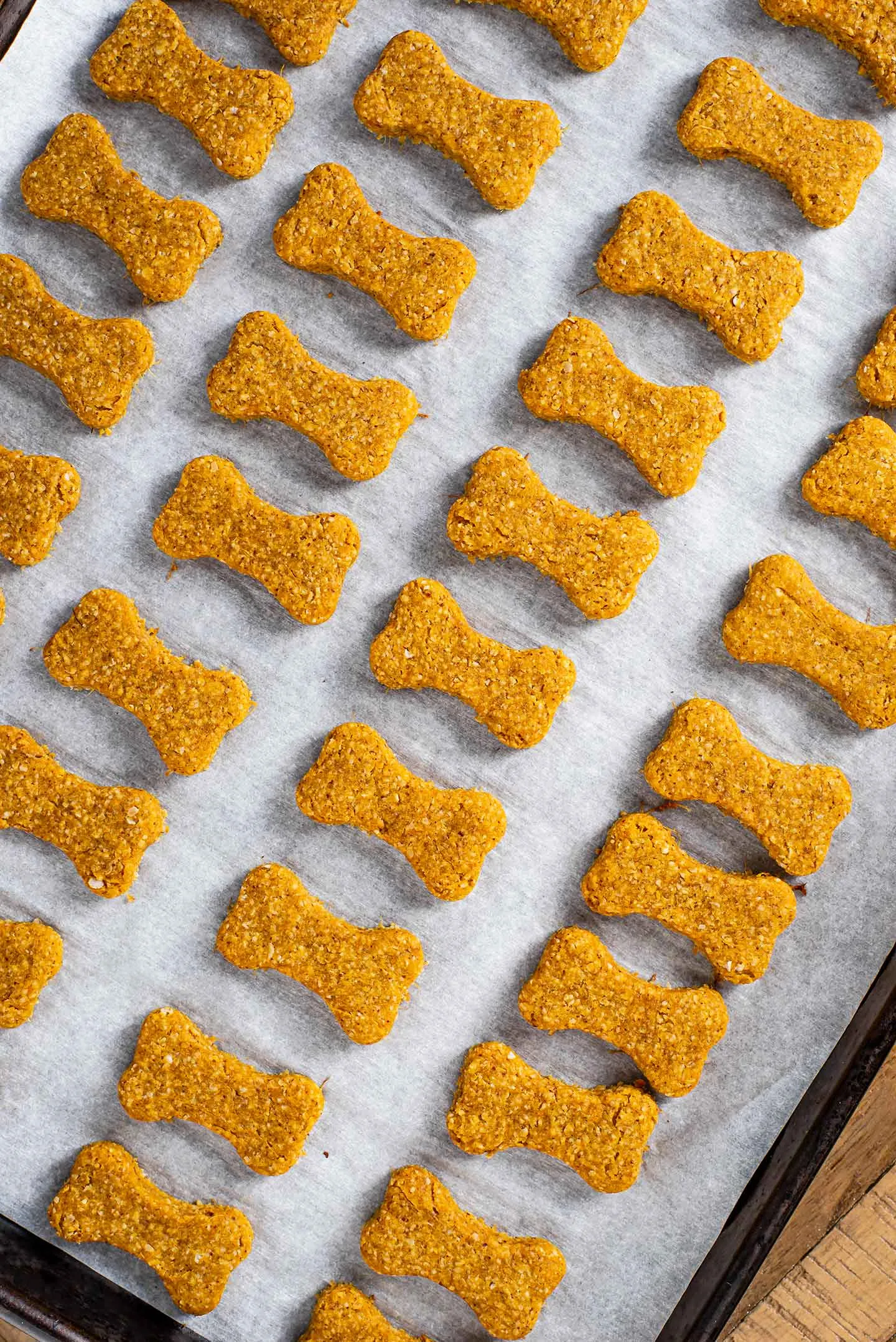Show your best friend some love with these incredibly simple and quick homemade dog treats! As a dedicated expert at Dog Care Story, we understand the desire to provide healthy, safe, and delicious snacks for your canine companion. This recipe for 3 Ingredient Dog Treats No Banana is designed to be free from common allergens, packed with fiber, and super tasty, ensuring a wagging tail without any added fuss. What’s more, these budget-friendly biscuits cost just pennies to make, offering a heartwarming alternative to expensive store-bought options.
Making your own treats ensures you know exactly what your dog is eating, avoiding unnecessary additives, preservatives, or sweeteners. It’s a fantastic way to control their diet and cater to specific health needs or sensitivities. For a broader understanding of what constitutes a truly balanced diet, you might find our guide on what is healthy for a dog to eat exceptionally useful.
 Delicious golden-brown dog bone treats on a white plate, showcasing a healthy homemade snack.
Delicious golden-brown dog bone treats on a white plate, showcasing a healthy homemade snack.
The Simple 3 Ingredients (No Banana Needed!)
The beauty of this recipe lies in its minimalist approach. You only need three core ingredients, and rest assured, bananas are not among them! This makes it perfect for dogs who may not enjoy bananas or whose owners prefer to avoid them.
Sweet Potato or Pumpkin Puree: A Healthy Base
The first star ingredient is cooked sweet potato, mashed, or unsweetened pumpkin puree. Both are fantastic, nutrient-dense options for dogs, offering vitamins, minerals, and dietary fiber.
- Sweet Potato: Rich in beta-carotene, which converts to Vitamin A, and beneficial for healthy skin, coat, and eyes.
- Pumpkin Puree: Excellent for digestive health, helping with both constipation and diarrhea. It’s crucial to use 100% pure pumpkin puree, not pumpkin pie filling, which contains added sugars and spices that can be harmful to dogs.
If you opt for pumpkin, and your dog loves it, you’ll be happy to know we have other delightful options like homemade pumpkin dog treats recipes vet approved that your furry friend might enjoy.
All-Natural Peanut Butter: The Flavorful Binder
Next up is all-natural peanut butter. This provides the binding element and a flavor dogs adore. However, careful selection is paramount:
- Check the Label: Ensure the only ingredient listed is peanuts.
- Avoid Xylitol: Many peanut butter brands contain xylitol, an artificial sweetener that is highly toxic to dogs and can be life-threatening. Always double-check labels meticulously.
Oat Flour: The Allergen-Friendly Choice
Our third ingredient is oat flour, which offers a great gluten-free alternative to wheat-based flours, making these treats suitable for dogs with wheat sensitivities.
- Making Oat Flour: You can easily make oat flour by grinding regular quick or rolled oats in a food processor or blender until a fine powder is formed.
- Whole Wheat Alternative: If your dog does not have wheat sensitivities, whole wheat flour can be used as a direct substitute, eliminating the need for grinding oats.
 Three simple dog treat ingredients laid out: a whole sweet potato, a bowl of creamy peanut butter, and a measuring cup of rolled oats next to a bone-shaped cookie cutter.
Three simple dog treat ingredients laid out: a whole sweet potato, a bowl of creamy peanut butter, and a measuring cup of rolled oats next to a bone-shaped cookie cutter.
Making the Dough: A Breeze for Busy Pet Parents
Are you ready for how incredibly easy this is? Let’s get baking!
Prepping Your Star Ingredient: Sweet Potato
If you’re using raw sweet potato, here are some quick ways to prepare it:
- Boiling: Peel and cube the sweet potato, then boil until soft. Mash thoroughly.
- Baking: Bake whole sweet potatoes at 425°F (220°C) for 40-55 minutes until soft and the skin pulls away. Once cool, remove the skin and mash.
- Freezing Tip: You can even freeze mashed or whole cooked sweet potato in portions for quick treat making later! Just defrost quickly in the microwave when needed.
Combining for Canine Happiness
In a mixing bowl, stir together the mashed sweet potato (or pumpkin puree) and the all-natural peanut butter until well combined.
![]() A glass bowl containing mashed sweet potato and smooth peanut butter, ready to be mixed with a silicone spatula for dog treats.
A glass bowl containing mashed sweet potato and smooth peanut butter, ready to be mixed with a silicone spatula for dog treats.
Achieving Perfect Dough Consistency
Next, add your oat flour (or whole wheat flour) to the wet mixture. Stir initially with a spoon, then use your hands to combine fully. The dough will be slightly sticky, which is perfectly normal.
- Too Dry? Add a splash of water, unsweetened oat milk, or a tiny bit more peanut butter or sweet potato.
- Too Sticky? Incorporate a dash more flour until the dough is manageable.
When preparing treats for puppies, it’s always good to be mindful of all ingredients. For additional guidance, consult our resource on what food can puppies not eat.
 A perfectly kneaded ball of golden-brown 3-ingredient dog treat dough, ready for rolling and cutting.
A perfectly kneaded ball of golden-brown 3-ingredient dog treat dough, ready for rolling and cutting.
Rolling, Shaping, and Baking Your Treats to Perfection
This is where you can truly personalize these 3 ingredient dog treats no banana for your beloved pet!
Rolling Out the Dough
Transfer the dough to a silicone mat or a piece of wax paper. Roll it out to a thickness of about ¼” to ½”. Since there are no rising agents, the thickness you choose now will be the final thickness of your baked treats.
- Sticky Dough Tip: If the dough sticks to your rolling pin, place another piece of wax paper over the dough before rolling.
- Crumbling Dough Tip: Don’t hesitate to scoop the dough back up, add a bit more wet ingredient (water, oat milk, or peanut butter/pumpkin), and re-roll.
Customizing Shapes and Thickness
- Cookie Cutters: Use your favorite dog-bone shaped cutters for classic treats, or experiment with different shapes. Opt for larger cutters for bigger dogs and smaller ones for petite pups.
- Simple Squares: No cookie cutters? No problem! Simply slice the rolled-out dough into small squares.
- Soft vs. Crunchy: Adjust the thickness to your dog’s preference – thinner for crunchier, thicker for chewier.
Baking for Optimal Texture
Preheat your oven to 400°F (200°C). Arrange your cut-out treats on a parchment-lined baking sheet.
- Bake Time: 10-15 minutes.
- Softer Treats: Bake for 10-12 minutes for a softer, chewier biscuit.
- Crunchier Treats: Bake for 15 minutes for a crispier, crunchier texture that takes a little longer to enjoy.
 Rows of freshly baked, bone-shaped homemade dog treats cooling on a parchment-lined baking sheet, golden and ready to enjoy.
Rows of freshly baked, bone-shaped homemade dog treats cooling on a parchment-lined baking sheet, golden and ready to enjoy.
Storing Your Homemade Goodies
Once baked, allow the treats to cool completely. Store them in an airtight container in the refrigerator for up to one week. For longer storage, these treats freeze beautifully for up to two months. Simply thaw them in the fridge or at room temperature before serving.
3-Ingredient Dog Treats Recipe (No Banana) – The Full Guide
These easy, 3-ingredient homemade dog treats are high in fiber, free of common dog allergens, and incredibly rewarding for both your dog and your wallet!
Ingredients
- 1 cup oat flour (or whole wheat flour if your dog is not sensitive to wheat)
- ¼ cup all-natural peanut butter (ensure the only ingredient is peanuts; no sweeteners or additives like xylitol)
- ½ cup cooked sweet potato, mashed (or unsweetened pumpkin puree)
Instructions
- Preheat your oven to 400°F (200°C) and line a baking sheet with parchment paper.
- In a bowl, stir together the mashed sweet potato (or pumpkin puree) and the all-natural peanut butter until well combined.
- Gradually add the oat flour (or whole wheat flour). If using oat flour, you can easily make it yourself by grinding quick or rolled oats into a fine flour using a food processor or blender.
- Mix the flour into the wet ingredients using a spoon or your hands until a cohesive dough forms. The dough may be slightly sticky. If it feels too dry, add a splash of water or unsweetened oat milk. If it’s too sticky to handle, add a bit more flour until it’s workable.
- Transfer the dough to a silicone mat or a piece of wax paper. Roll it out to a thickness of between ¼” and ½”. (Placing another piece of wax paper on top can prevent sticking).
- Use your favorite biscuit cutter to cut out shapes, or simply slice the dough into small square treats. Remember, these treats won’t rise, so their baked thickness will match their raw thickness.
- Carefully transfer the cut-out treats to your prepared baking sheet.
- Bake for 10-15 minutes at 400°F (200°C). For softer treats, bake for 10-12 minutes. For a crunchier texture, bake for the full 15 minutes.
- Allow the treats to cool completely on the baking sheet before storing.
Notes
- Approximate Cost: This recipe can cost as little as $0.83 CAD for 40-50 small treats, significantly cheaper than store-bought options.
- Sweet Potato Preparation: To cook raw sweet potato, peel and boil until soft, or bake at 425°F (220°C) for 40-55 minutes until cooked through. Allow to cool, peel, and mash. Leftovers can be frozen for future use.
- Substitutions: Feel free to substitute sweet potato with unsweetened pure pumpkin puree (not pie filling) or even cooked and mashed carrot.
- Prep Time: 15 minutes
- Cook Time: 15 minutes
- Category: Thrifty How-Tos
- Method: Baked
- Cuisine: American, Canadian
Final Thoughts: A Simple Way to Show Love
Making these 3 ingredient dog treats no banana is a wonderful way to express your love for your dog. It’s a simple, cost-effective, and healthy alternative to commercial treats, ensuring your furry friend gets only the best. Plus, the joy of seeing their excitement over a treat you made yourself is truly priceless!
Always remember to consult your veterinarian before introducing any new foods or treats into your dog’s diet, especially if they have existing health conditions or dietary restrictions. While these treats are generally safe, understanding specific needs is crucial. For information on foods to completely avoid, check out our comprehensive guides on what fruits can dogs not eat list and what fruits should you not give your dog to keep your canine companion safe and healthy.
Stay tuned to Dog Care Story for more homemade dog recipes, pet health tips, and expert advice to help you give your dog the happiest, healthiest life possible!
